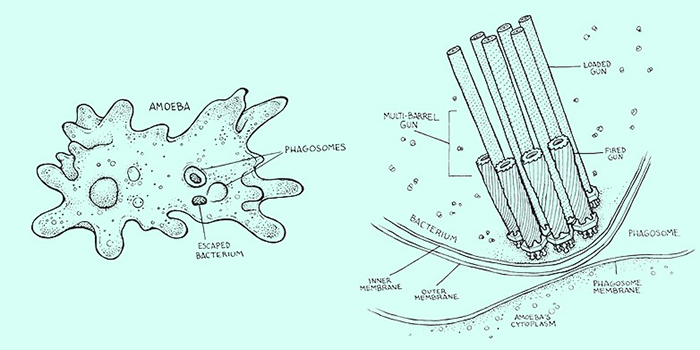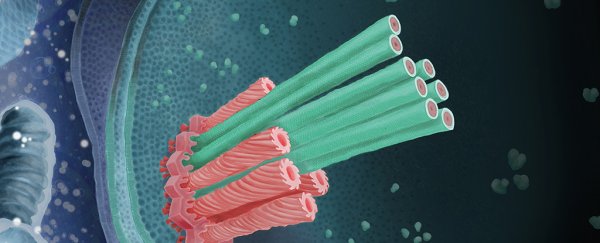After years of research, scientists have worked out how some bacteria are able to survive inside amoebae – by stabbing them with microscopic daggers to prevent digestion.
This miniature game of biological swordplay was discovered through a new method where amoebae are frozen to minus 180°C (minus 292°F) and then gradually chiselled with a focussed ion beam, revealing the bacteria like a fossil buried in the earth.
According to the team from the University of Vienna in Austria and ETH Zurich in Switzerland, it's a look at a biological process in the sort of detail we don't usually get to see: as well as the micro-daggers, the scientists discovered sheaths, a baseplate, and an anchoring platform.
"The sheath is spring-loaded and the micro-dagger lies inside it," says one of the researchers, João Medeiros from ETH Zurich. "When the sheath contracts, the dagger is shot outwards extremely quickly through the bacterial membrane."
 Credit: Leo Popovich/ETH Zurich
Credit: Leo Popovich/ETH Zurich
"Our results suggest that the bacteria are able to shoot the dagger into the membrane of the amoeba's digestive compartment," adds another of the team, Désirée Böck from ETH Zurich.
The research builds on previous work into the way hungry amoebae hunt down and digest bacteria, making the two microorganisms deadly enemies.
However, some bacteria – including the Amoebophilus type studied here – can defend themselves against an amoeba attack, and the purpose of this new research was to work out how.
Thanks to the "nano-chisel" approach of the focussed ion beam, the researchers were able to close the gap between cell biology (studying how cells work) and structural biology (figuring out how the individual parts fit together).
Through the micro-dagger mechanism that's been discovered, the bacteria can break the amoeba's special digestive compartment and carry on thriving while still inside the amoeba, though it's still not quite clear how the digestive membrane disintegrates.
It's possible that the daggers are tipped with a kind of poison, the researchers say – with membrane-degrading enzymes perhaps, the blueprints for which are written in the bacteria's genome.
These micro-daggers have been spotted elsewhere in biology before, including in bacteriophages, viruses that specialise in infecting bacteria. However, in this case, researchers found clusters of up to 30 micro-daggers together, like "multi-barrel guns" – something that hasn't been seen before.
Based on comparisons of genomes, the scientists think these micro-daggers could be found in at least nine of the most important bacterial groups, though whether they would also be used to prevent death-by-digestion remains to be seen.
Meanwhile the cryo-focussed ion beam milling technique is set to be used in more and more studies of microorganisms like these.
"The technique could help to address many other questions in cell, infection and structural biology, says Medeiros. "We are already working with other research groups and offering them our expertise."
The findings have been published in Science.
